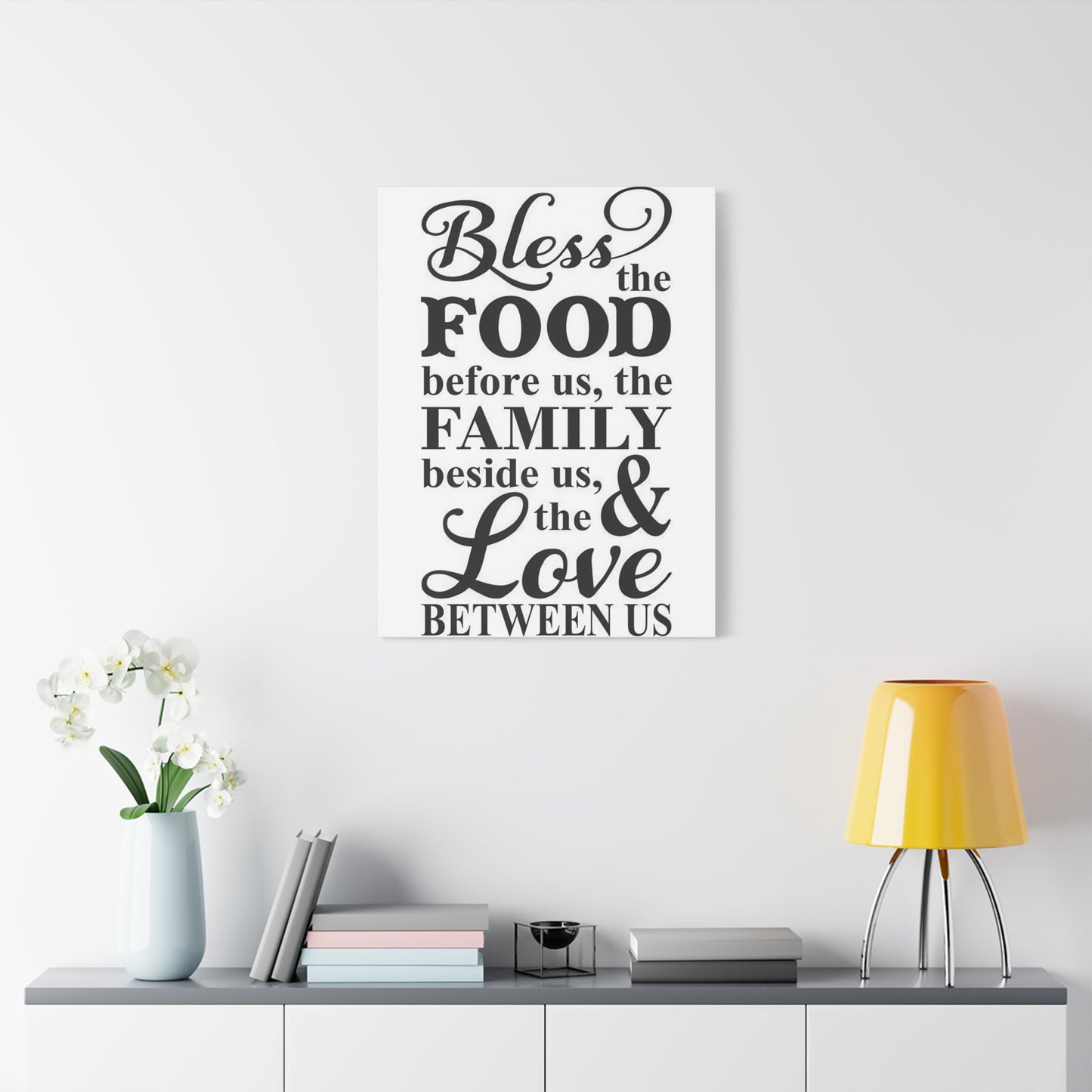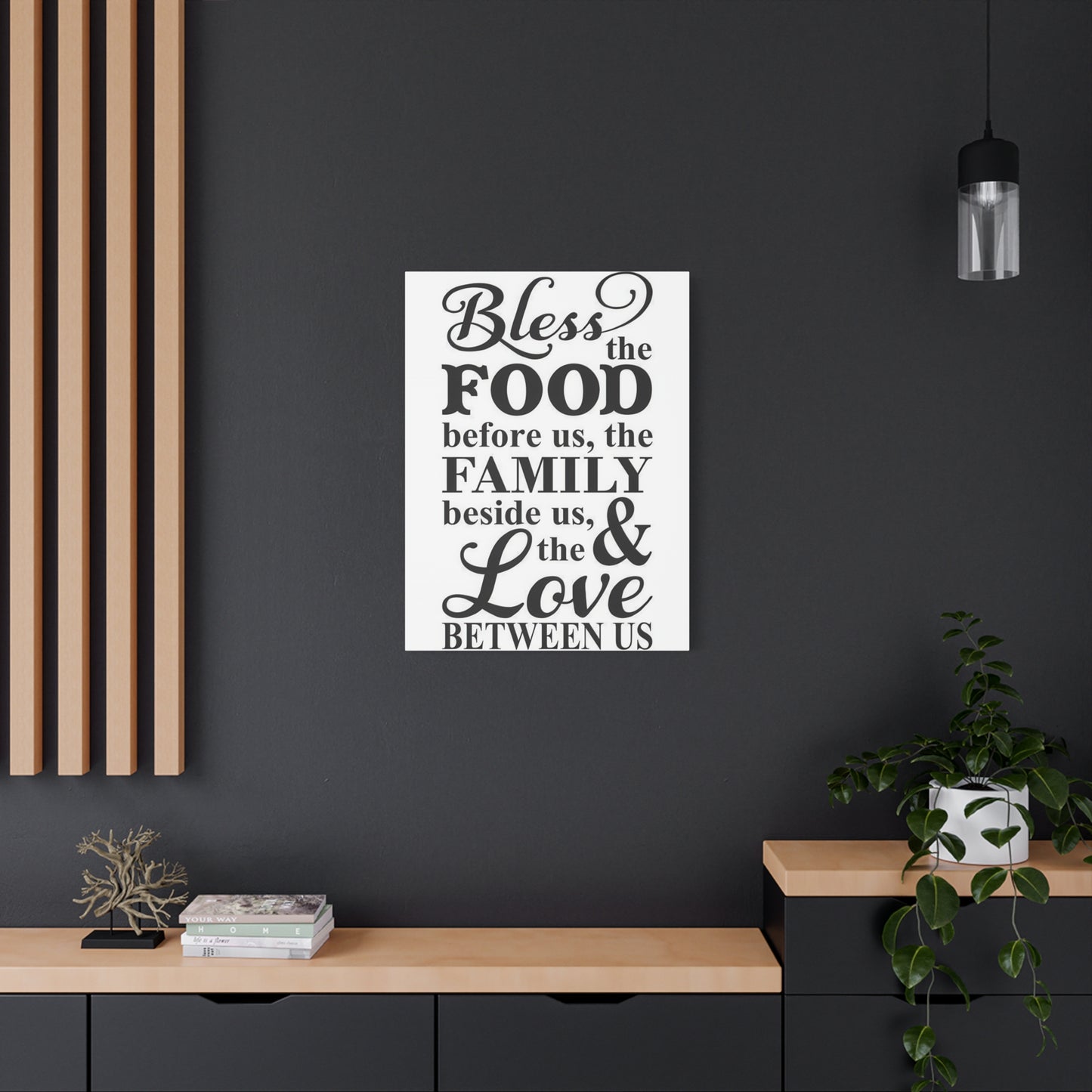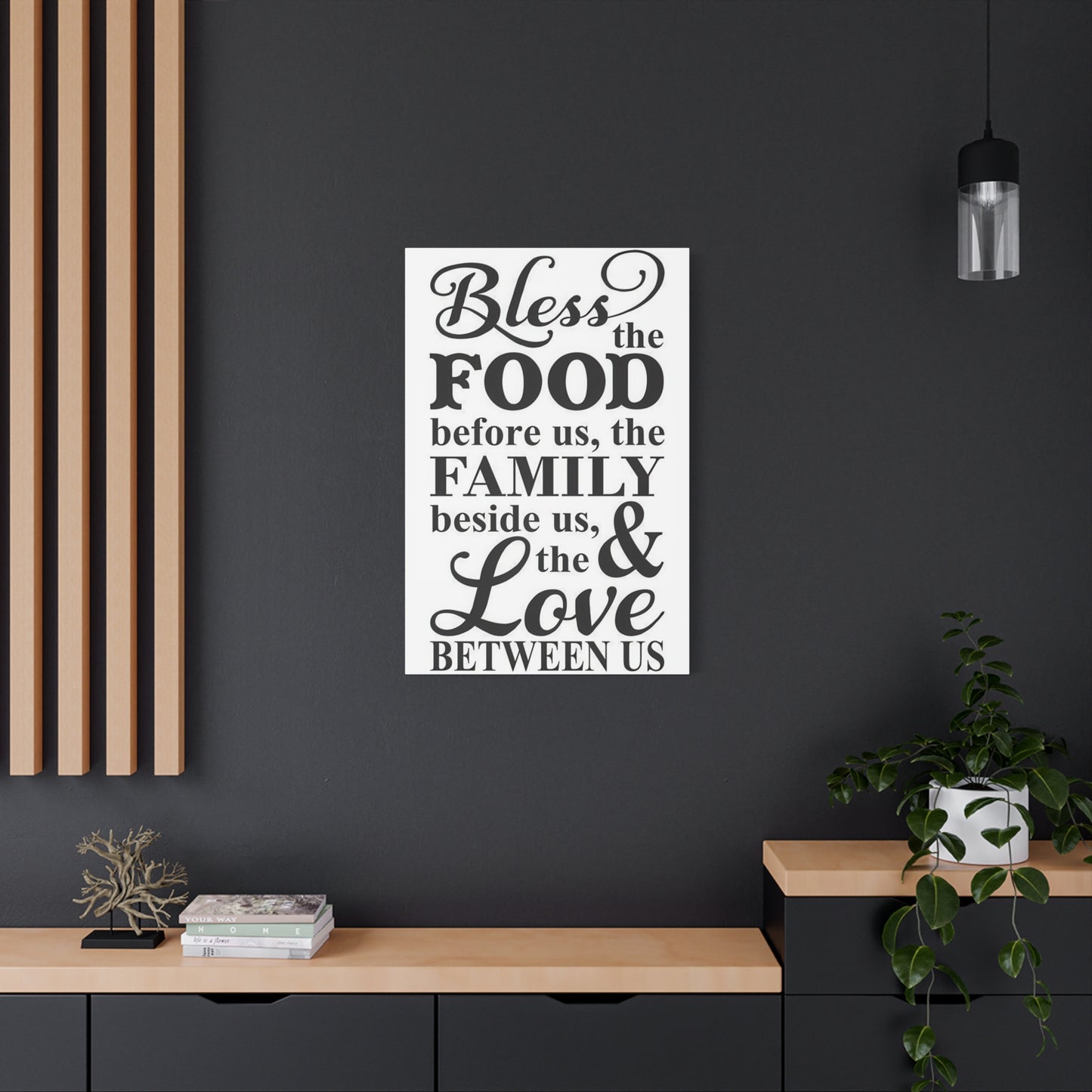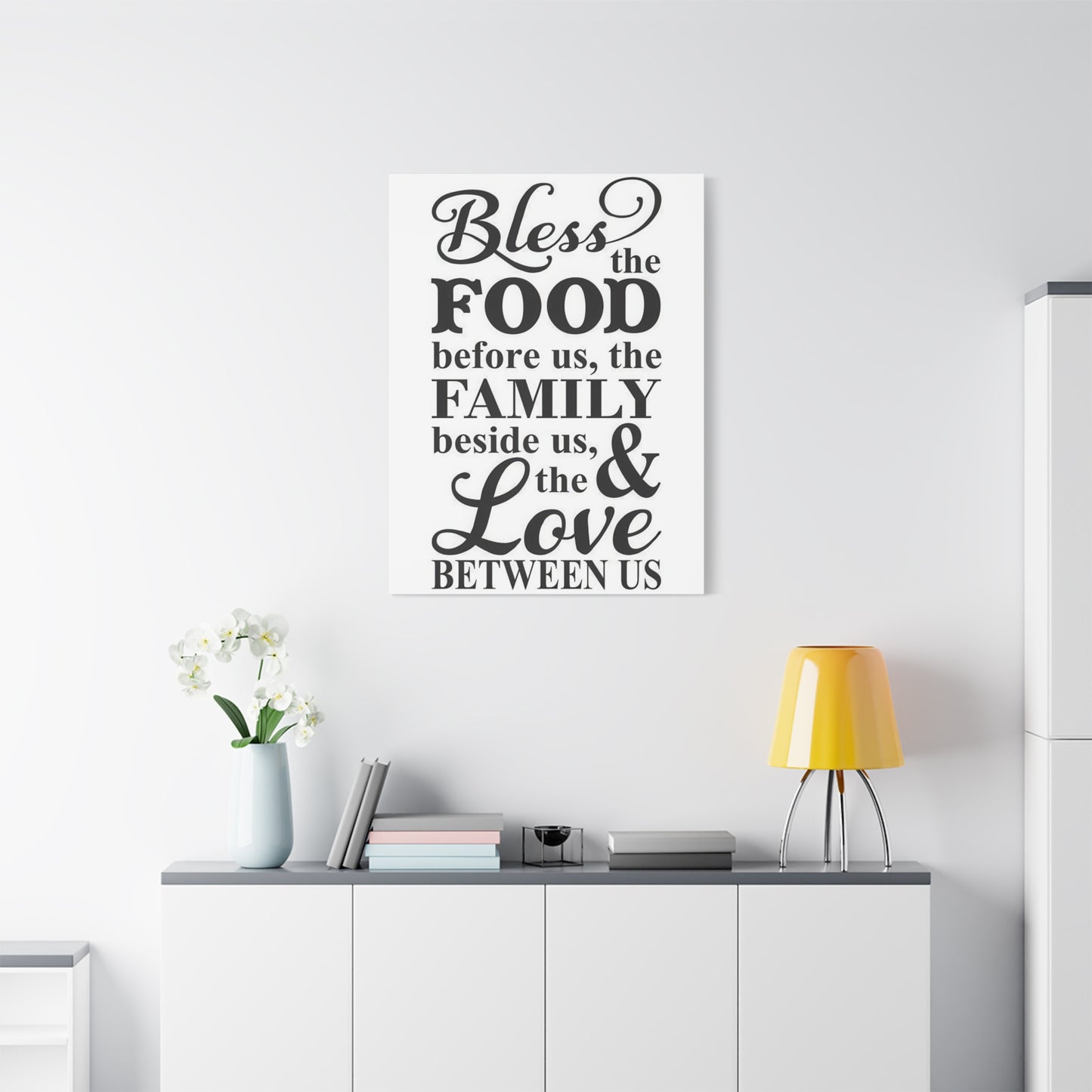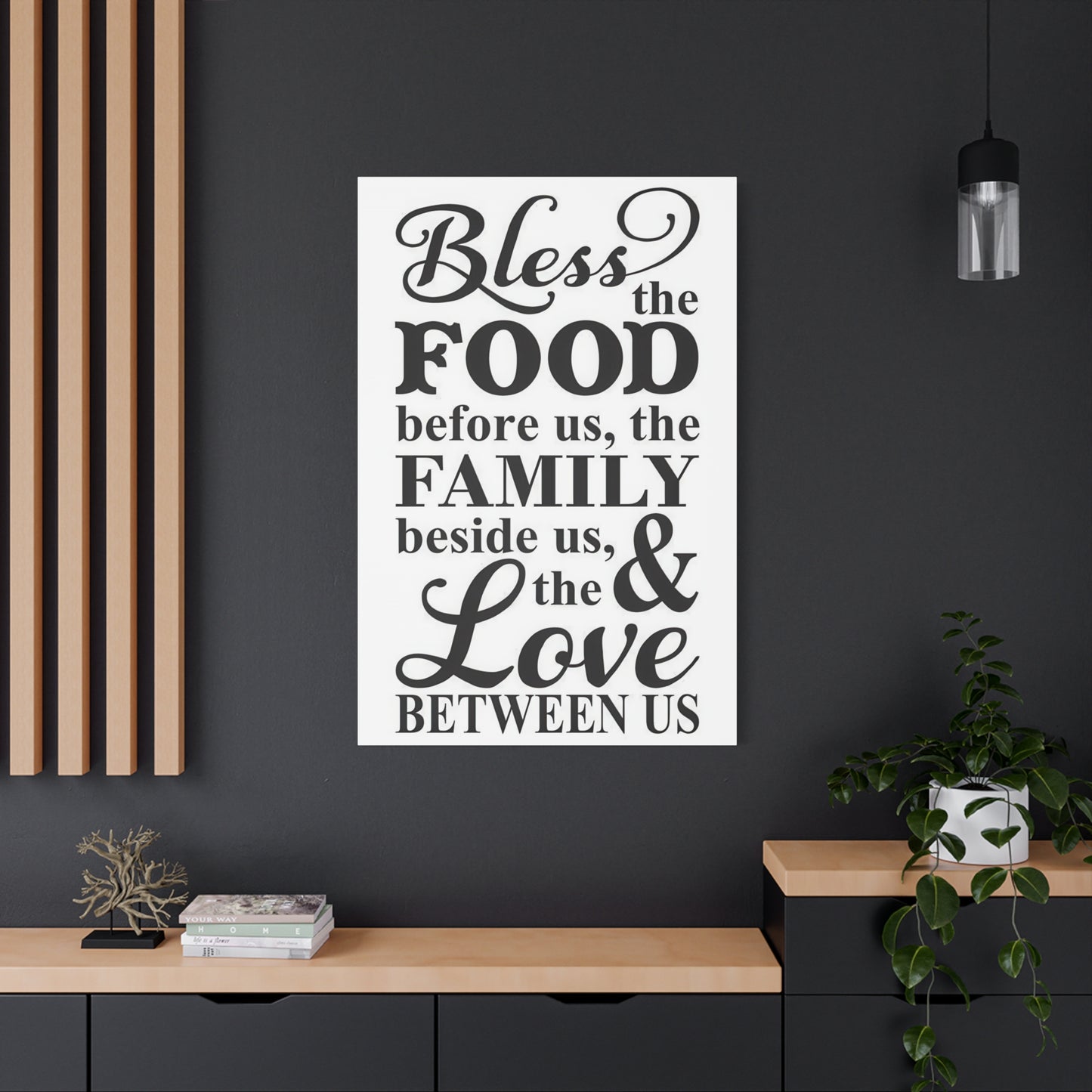Heart of the Home: Why "Bless Food Family Love Wall Art" is Essential for Your Kitchen or Dining Area
There exists something profoundly touching about displaying meaningful phrases within the spaces where we gather, share meals, and create lasting memories with those we cherish most. The simple yet powerful message conveyed through artistic pieces featuring blessings for nourishment, kinship, and affection resonates deeply with individuals seeking to infuse their living spaces with warmth and intention. These decorative elements serve as more than mere adornments for walls; they function as daily affirmations of what truly matters in our lives.
The appeal of such heartfelt expressions stems from their ability to capture universal values that transcend cultural boundaries and generational differences. When we choose to display words that celebrate the essentials of a fulfilling life—sustenance, relationships, and compassion—we make a conscious decision to prioritize these elements in our daily existence. This type of artwork speaks to the soul in ways that abstract pieces or purely decorative items cannot, offering both visual interest and emotional significance.
In our fast-paced modern world, where technology often dominates our attention and schedules fill every available moment, having visible reminders of life's fundamental blessings becomes increasingly important. These artistic expressions serve as anchors, grounding us in the present moment and redirecting our focus toward gratitude and connection. They transform ordinary rooms into sanctuaries of appreciation, where every glance at the wall reinforces our commitment to cherishing the simple yet profound gifts we often take for granted.
The versatility of such meaningful artwork allows it to adapt to various interior design preferences while maintaining its core message. Whether your home features contemporary minimalism, traditional elegance, farmhouse charm, or eclectic bohemian style, pieces celebrating nourishment, relationships, and affection can be incorporated seamlessly. This adaptability ensures that the emotional impact of the message remains consistent regardless of the surrounding aesthetic choices.
Furthermore, the emotional resonance of these words creates an atmosphere that visitors immediately sense upon entering your home. Guests feel welcomed into a space where values align with creating meaningful experiences rather than simply showcasing material possessions. This subtle yet powerful statement about your priorities communicates volumes about the type of environment you wish to cultivate for yourself and those you invite into your personal spaces.
The tactile and visual qualities of these artistic pieces also contribute to their appeal. Many designs feature carefully selected typography that enhances the message's impact, while others incorporate complementary imagery such as farmhouse elements, natural motifs, or vintage-inspired details. The craftsmanship evident in well-executed pieces demonstrates respect for both the message and the viewer, elevating the work beyond mass-produced decorations to something worthy of contemplation and appreciation.
Choosing to display such meaningful expressions also reflects a commitment to conscious living and intentional design. Rather than filling walls with random decorations selected solely for color coordination or trend-following purposes, these pieces represent thoughtful decisions about the energy and atmosphere you wish to cultivate in your home. This intentionality extends beyond aesthetics to encompass the daily psychological and emotional benefits of surrounding yourself with affirming messages.
The longevity of these artistic statements ensures they remain relevant through changing trends and evolving personal tastes. While color schemes may shift and furniture styles may update over time, the fundamental appreciation for sustenance, kinship, and compassion remains constant. This timeless quality makes such pieces excellent long-term investments that continue providing value and meaning for years or even decades after their initial installation.
Why Bless Food Family Love is Perfect for the Kitchen
The kitchen holds a special place in the home as the gathering spot where nourishment is prepared, conversations flow freely, and countless memories are created around shared meals. This central hub of domestic life deserves decorative elements that reflect its importance and enhance its welcoming atmosphere. Artwork celebrating the fundamental blessings of sustenance, relationships, and affection naturally belongs in this space where these very elements come together daily.
When you prepare meals in a kitchen adorned with meaningful expressions of gratitude and appreciation, the act of cooking transforms from routine task to intentional practice. These visual reminders encourage mindfulness about the nourishment you provide for yourself and others, fostering a deeper connection to the sustenance you create. This shift in perspective can make even the most mundane meal preparation feel more purposeful and satisfying, as you're constantly reminded of the love and care you're putting into feeding those who matter most.
The kitchen environment benefits particularly from messages that acknowledge the intersection of physical nourishment and emotional connection. These spaces witness not only the preparation of meals but also the late-night conversations over tea, the morning coffee rituals that start the day, the homework sessions at the counter, and the impromptu dance parties while waiting for water to boil. Artwork that celebrates these multifaceted experiences validates the kitchen's role as more than a utilitarian space, recognizing it as the heart of the home where life truly happens.
Positioning such meaningful pieces in the kitchen also creates natural conversation starters when guests visit. Friends and family members often gravitate toward the kitchen during gatherings, and having thought-provoking artwork displayed prominently provides opportunities for deeper discussions about values, gratitude, and what makes a house feel like a home. These conversations strengthen relationships and create the very connections the artwork celebrates, generating a beautiful cycle of appreciation and bonding.
The practical considerations of kitchen artwork also favor pieces with clear, bold messaging that can be appreciated even during busy moments. When you're rushing to prepare breakfast before work or orchestrating multiple dishes for a holiday dinner, you may not have time to contemplate complex abstract art, but a simple, powerful statement catches your eye and provides a moment of grounding even amid chaos. This accessibility makes such pieces particularly valuable in high-traffic, high-activity spaces like kitchens.
From a design perspective, kitchens often feature significant wall space that benefits from focal points beyond cabinets and appliances. Large or medium-sized artwork celebrating fundamental blessings fills this space beautifully, adding personality and warmth to areas that might otherwise feel purely functional. The right piece can balance the hard surfaces and industrial elements common in kitchens with softer, more emotional touches that make the space feel lived-in and loved.
The kitchen's association with hospitality and generosity aligns perfectly with artwork emphasizing gratitude for sustenance and relationships. When you invite others into your home and prepare meals for them, you're participating in one of humanity's oldest expressions of care and community. Having visual representations of these values displayed in your cooking space reinforces your commitment to this tradition and reminds you of the deeper significance behind the act of feeding others.
Many kitchen designs incorporate open concepts that allow views into dining areas or living spaces, making cohesive decorative choices particularly important. Artwork celebrating blessings serves as an ideal anchor piece that can tie together these connected spaces, creating visual and thematic continuity throughout your home's main gathering areas. This unified approach to decorating enhances the overall aesthetic while reinforcing consistent values throughout your living environment.
The durability considerations for kitchen artwork also matter, as these spaces experience temperature fluctuations, humidity from cooking, and general wear from heavy use. High-quality pieces designed for such environments ensure your meaningful message remains vibrant and intact despite these challenging conditions. Investing in properly constructed artwork demonstrates the same care and attention to quality that you bring to the meals you prepare in this space.
Finally, the kitchen represents the perfect location for expressions of gratitude because this space literally sustains life. Every meal prepared, every snack assembled, every drink poured contributes to the physical wellbeing of your household. Acknowledging this fundamental function with artwork that celebrates nourishment creates a beautiful synergy between the space's purpose and its decorative elements, resulting in a kitchen that feels both purposeful and deeply personal.
Creating Warmth with Bless Food Family Love Wall Art
The atmosphere of a home extends far beyond its physical characteristics of square footage, architectural details, or furnishing choices. True warmth comes from the intangible qualities that make a space feel inviting, comfortable, and emotionally nourishing. Artwork featuring heartfelt messages about life's essential blessings plays a crucial role in creating this warmth by infusing rooms with intentionality, gratitude, and genuine affection for the people and experiences that make life meaningful.
When you select decorative pieces that express appreciation for sustenance, kinship, and compassion, you're making a deliberate choice to prioritize emotional resonance over purely aesthetic considerations. This decision communicates to everyone who enters your home that you value substance over superficiality, meaning over trendiness, and connection over perfection. The resulting atmosphere feels authentic and welcoming in ways that carefully styled but emotionally empty spaces never achieve.
The visual impact of well-designed meaningful artwork contributes significantly to creating warmth. Typography choices, color palettes, and accompanying design elements all work together to evoke specific emotional responses. Pieces featuring warm neutrals, rustic textures, or hand-lettered fonts tend to generate feelings of comfort and approachability, while cleaner, more modern interpretations of the same messages create warmth through their clarity and intentionality. Understanding how different design approaches affect the overall feeling allows you to select pieces that align with your desired atmosphere.
Placement strategies also influence how effectively artwork creates warmth throughout your space. Positioning meaningful pieces at eye level ensures they're noticed and appreciated regularly, while thoughtful arrangement in relation to furniture and other decorative elements helps integrate them naturally into your overall design scheme. Consider placing such artwork in locations where people naturally pause or gather, maximizing opportunities for the message to be received and contemplated.
The psychological effects of surrounding yourself with affirming messages should not be underestimated. Research in environmental psychology demonstrates that our physical surroundings significantly influence our mental states, emotional wellbeing, and even our behavior patterns. When your walls display expressions of gratitude and appreciation, these positive messages subtly reinforce your own values and encourage mindsets aligned with contentment and connection. Over time, this environmental influence can genuinely shift your perspective toward greater appreciation for life's blessings.
Creating warmth through artwork also involves considering how pieces interact with natural and artificial lighting. Well-lit displays ensure the message remains visible and impactful throughout the day, while strategic positioning can create interesting shadows or highlights that add depth and dimension to the piece. Some homeowners choose to add accent lighting specifically to showcase meaningful artwork, treating these pieces with the reverence typically reserved for fine art in galleries or museums.
The layering approach to wall decoration allows you to build warmth gradually by combining meaningful text-based pieces with complementary elements like photographs, smaller accent pieces, or natural materials. This curated approach prevents walls from feeling too sparse or too cluttered while allowing you to tell a more complete visual story about your values and priorities. The key lies in maintaining cohesion through color, style, or theme while still allowing individual pieces to make their unique contributions.
Personal connections to the messages displayed enhance the warmth they create exponentially. When artwork expresses sentiments that genuinely resonate with your life experiences, beliefs, or aspirations, it transcends decoration to become a reflection of your authentic self. This authenticity radiates throughout your space, making it feel more personal and inviting than homes filled with generic decorations selected primarily for their appearance rather than their meaning.
The conversational warmth generated by meaningful artwork should not be overlooked either. When guests comment on or ask about pieces celebrating fundamental blessings, they're opening doors to deeper conversations about shared values, life philosophies, and what truly matters. These exchanges create emotional warmth and connection that extends far beyond the initial visual impact of the artwork itself, fostering relationships and understanding among those who gather in your space.
Seasonal considerations can also play a role in how artwork contributes to warmth throughout the year. While the core message remains constant, you might choose to surround such pieces with seasonal accents that enhance their relevance and impact during different times of year. During autumn, for example, emphasizing gratitude themes feels particularly appropriate, while summer might call for highlighting the communal aspects of sharing meals and gathering with loved ones outdoors.
How Bless Food Family Love Adds Charm to Dining Rooms
The dining room occupies a unique position in home design as a space specifically dedicated to the ritual of sharing meals and conversation. This designated gathering place deserves decorative elements that enhance its primary function while adding visual interest and personality. Artwork celebrating fundamental life blessings brings undeniable charm to dining spaces by acknowledging the deeper significance of what occurs within these walls beyond simple consumption of food.
The charm created by meaningful expressions in dining rooms stems partly from their ability to set intentions for the experiences that unfold in this space. When diners gather around a table beneath words celebrating nourishment, relationships, and affection, these concepts become focal points for the meal itself. Conversations may naturally drift toward topics of gratitude, family updates, or expressions of appreciation that might not arise in the absence of such visual prompts. The artwork essentially creates a framework for more meaningful interactions.
From an aesthetic perspective, the often formal or semi-formal nature of dining rooms benefits from the softening effect of heartfelt messages. Where dining spaces can sometimes feel stiff or intimidating, especially in homes with separate formal dining rooms used primarily for special occasions, warm expressions of gratitude and appreciation make the space feel more approachable and welcoming. This balance between elegance and warmth creates an ideal atmosphere for both casual family dinners and more elaborate entertaining occasions.
The scale of dining room artwork matters significantly in creating the desired impact. These spaces typically offer substantial wall areas that can accommodate larger pieces capable of making bold statements without overwhelming the room. A generously sized piece celebrating life's blessings commands attention while remaining appropriate for the space's proportions, whereas undersized artwork may get lost amid the visual weight of dining tables, chairs, and serving pieces.
Color coordination between meaningful artwork and dining room elements enhances overall charm while maintaining visual cohesion. Many such pieces feature neutral palettes that complement a wide range of china patterns, table linens, and decorative accessories, allowing you to change these elements seasonally or for special occasions without creating visual discord. This versatility ensures your investment in meaningful artwork continues working beautifully with your dining room aesthetic over time despite other changes.
The dining room's role as a transitional space between kitchen and living areas in many home layouts makes it ideal for artwork that bridges different functional zones. Pieces celebrating blessings naturally connect the nourishment created in kitchens with the relaxation and bonding that occur in family rooms, serving as thematic links that unify your home's public spaces around shared values and priorities. This continuity creates a sense of intentionality and cohesion throughout your home's design.
Historical and cultural associations with dining rituals add another layer of meaning to such artwork in these spaces. Humans have gathered for communal meals since ancient times, and many cultures incorporate prayers, blessings, or expressions of gratitude as integral parts of dining traditions. Displaying artwork that acknowledges these timeless practices connects your modern dining room to this rich heritage, adding depth and significance to contemporary meal sharing.
The practical consideration of viewing angles in dining rooms also favors meaningful text-based artwork. Unlike living rooms where people may sit facing various directions, dining rooms naturally orient everyone toward a central table, often with at least one prominent wall in most diners' line of sight. Positioning your meaningful piece on this focal wall ensures maximum visibility and impact during meals when the dining room serves its primary purpose.
Lighting plays a crucial role in showcasing dining room artwork effectively. Many dining spaces feature statement lighting fixtures like chandeliers or pendant lights that can be positioned to illuminate wall art beautifully. This coordination between lighting design and artwork placement creates dramatic visual effects while ensuring the meaningful message remains clearly visible during evening meals when dining rooms see heavy use in many households.
The emotional associations people develop with dining rooms further enhance the impact of meaningful artwork in these spaces. Many individuals' most cherished memories involve meals shared with loved ones around dining tables—holiday celebrations, milestone announcements, everyday dinners filled with laughter and conversation. Having artwork that explicitly celebrates these values and experiences validates the importance of these memories while encouraging the creation of new ones.
Bless Food Family Love: A Daily Reminder for Your Home
In the constant rush of modern life, maintaining awareness of what truly matters requires intentional effort and regular reinforcement. The demands of careers, household management, social obligations, and personal pursuits can easily overshadow quieter moments of appreciation and connection. Strategically placed artwork featuring messages about life's fundamental blessings serves as a powerful tool for maintaining perspective and cultivating gratitude as ongoing practices rather than occasional thoughts.
The daily reminder aspect of such artwork functions on both conscious and subconscious levels. Each time you deliberately notice and read the message, you create a moment of mindfulness that interrupts automatic thinking patterns and redirects attention toward appreciation. Even when your eyes pass over the piece without conscious acknowledgment, the words register on a deeper level, subtly influencing your mindset and emotional state throughout the day. This dual-level impact maximizes the artwork's effectiveness as a tool for maintaining positive focus.
Positioning these reminders in high-traffic areas ensures regular exposure that reinforces their messages through repetition. Locations like entryways, where you pass multiple times daily while coming and going, or hallways connecting different rooms create natural touchpoints for re-engaging with meaningful messages. These brief encounters accumulate over time, strengthening neural pathways associated with gratitude and appreciation until these mindsets become more automatic and natural.
The morning encounter with such artwork holds particular significance for setting daily intentions. When expressions of gratitude and appreciation greet you during early routines of making coffee, preparing breakfast, or getting ready for the day, they help establish a positive foundation for the hours ahead. This morning framing can influence how you interpret events, respond to challenges, and interact with others throughout your day, demonstrating how physical environment impacts mental and emotional states.
Evening interactions with meaningful artwork provide different but equally valuable benefits. After a long day's demands and stresses, returning home to visual reminders of what truly matters helps facilitate the transition from work mode to personal time. These messages encourage you to release tensions, appreciate the sanctuary of home, and reconnect with the people and practices that sustain and nourish you. This ritual of re-centering supports better work-life balance and enhanced presence during personal time.
The reminder function becomes especially valuable during challenging periods when stress, difficulty, or loss makes gratitude feel less accessible. When circumstances test your resilience and optimism, having concrete visual prompts to appreciate existing blessings provides essential perspective. The artwork serves as an anchor, reminding you of constants that remain even when specific situations feel overwhelming. This stabilizing influence supports emotional regulation and helps maintain hope during difficult times.
For households with children, meaningful artwork serves as a teaching tool that communicates values through environmental design. Young people absorb messages from their surroundings constantly, and growing up in homes that explicitly celebrate gratitude, nourishment, and relationships shapes their developing value systems. These visual elements support parents' efforts to instill appreciation and mindfulness in their children without requiring constant verbal reminders that may feel like nagging.
The cumulative effect of daily reminders manifests in gradual shifts toward more positive and appreciative mindsets. While a single viewing of meaningful artwork may create only a momentary impression, regular exposure over weeks, months, and years builds lasting changes in thought patterns and emotional habits. This transformation occurs largely through the psychological principle of environmental priming, where consistent exposure to stimuli influences behavior and attitudes even without conscious awareness of the influence.
Visitors to your home also benefit from these daily reminders during their time in your space. Friends and family members who spend time in your environment absorb the same messages that influence you, potentially carrying those thoughts with them when they leave. In this way, your choice to display meaningful artwork creates ripple effects that extend beyond your own household, spreading appreciation and positive focus into your broader community.
The physical permanence of displayed artwork distinguishes it from digital reminders or temporary notes that easily disappear or become ignored. Unlike phone notifications that can be dismissed or sticky notes that fall down and get lost, properly mounted artwork maintains constant presence in your space. This reliability ensures the reminder function continues indefinitely without requiring maintenance, updates, or replacement, making it a set-it-and-forget-it approach to environmental design for wellbeing.
Incorporating Bless Food Family Love in Your Decor
Successfully integrating meaningful artwork into existing decorative schemes requires thoughtful consideration of both aesthetic and emotional elements. The goal involves creating cohesion that allows the piece to feel like a natural, integral part of your overall design rather than an afterthought or mismatch that draws attention for the wrong reasons. With proper planning and creative thinking, such artwork can enhance virtually any decorating style while delivering its important message.
Understanding your current aesthetic serves as the essential first step in successful incorporation. Whether your home features modern minimalism, traditional elegance, rustic farmhouse charm, industrial edge, or eclectic mix-and-match style, identifying your dominant design elements helps you select or create artwork that complements these existing choices. The beauty of meaningful text-based pieces lies in their adaptability—the same message can be expressed through countless visual interpretations suitable for different design preferences.
Color coordination represents one of the most straightforward ways to ensure artwork integrates smoothly into your space. Analyzing your room's existing color palette and selecting pieces that either match these hues or provide complementary contrast creates visual harmony. Neutral-toned artwork works beautifully in virtually any setting, while pieces incorporating your accent colors create stronger connections to your overall scheme. Some homeowners choose to use such artwork as inspiration for updating room colors, building the entire palette around a meaningful piece they love.
Scale and proportion considerations prevent artwork from appearing too small to make an impact or too large for comfortable viewing. General design guidelines suggest artwork should occupy roughly sixty to seventy-five percent of the width of furniture pieces it hangs above, though this varies based on specific room configurations and personal preferences. In spaces without furniture anchors, consider the wall's overall dimensions and surrounding elements to determine appropriate sizing.
Framing choices significantly impact how well meaningful artwork integrates with surrounding decor. Traditional ornate frames suit classic or vintage-inspired interiors, while sleek modern frames complement contemporary spaces. Rustic wood frames enhance farmhouse or cottage aesthetics, and floating or gallery-style mounting works well in minimalist settings. Some pieces work beautifully without any frame at all, particularly those featuring their own decorative elements or printed on substantial materials like wood or canvas.
Creating gallery walls that incorporate meaningful text-based pieces alongside photographs, other artwork, and decorative objects allows for creative expression while building visual interest. This approach lets you tell a more complete story about your values and priorities while also showcasing family memories, artistic interests, and personality. The key to successful gallery wall design lies in planning the arrangement carefully before hanging anything, ensuring proper spacing and balance among disparate elements.
Layering techniques add depth and dimension to artwork displays while helping pieces integrate more naturally into their surroundings. Placing artwork on shelves or mantels with other objects arranged around and in front of it creates a curated, collected-over-time appearance rather than a recently purchased and hung look. This approach works particularly well for smaller pieces that might get lost on large expanses of empty wall but feel perfectly scaled when incorporated into vignettes with complementary objects.
Considering sightlines throughout your home helps identify ideal placement locations where meaningful artwork will be noticed and appreciated regularly. Think about which walls you naturally face when seated in various rooms, which areas you pass frequently during daily routines, and which spaces receive guests' attention when they visit. Positioning artwork in these high-visibility locations maximizes its impact and ensures regular engagement with its message.
Balancing symmetry and asymmetry in artwork placement depends largely on your overall design approach and the space's existing elements. Formal, traditional rooms often benefit from symmetrical arrangements that create calm, orderly impressions, while more casual or contemporary spaces may embrace asymmetrical placements that feel dynamic and energetic. Neither approach is inherently better; the choice should align with your aesthetic preferences and the room's existing character.
Updating accessories and complementary decor seasonally or periodically allows you to refresh your space without moving permanent artwork installations. By changing throw pillows, table decorations, or smaller accent pieces, you can give rooms new looks that highlight different aspects of meaningful artwork or coordinate with different seasons while maintaining core design elements. This approach provides variety and freshness without constant redecorating or major investments in new pieces.
The Power of Simple Words: Bless Food Family Love Art
Profound messages do not require elaborate language or complex concepts to resonate deeply with audiences. Often, the most powerful expressions of truth and meaning come through simple, straightforward words that cut through noise and pretension to address fundamental human experiences and values. Artwork featuring uncomplicated phrases about life's essential blessings demonstrates how economy of language can amplify rather than diminish emotional impact.
The accessibility of simple expressions ensures they communicate clearly across diverse audiences regardless of age, education level, or cultural background. While sophisticated vocabulary and nuanced concepts have their place in certain contexts, artwork intended to create welcoming atmospheres and shared experiences benefits from language that everyone immediately understands. This universality allows such pieces to speak to all who encounter them without creating barriers or exclusions based on linguistic complexity.
Simple words also lend themselves more readily to consistent daily engagement because they require minimal cognitive effort to process. When you're rushing through morning routines or exhausted at day's end, encountering straightforward expressions of gratitude and appreciation registers immediately without demanding the mental energy that more complex messages would require. This ease of comprehension ensures the artwork fulfills its reminder function even during moments when you have little attention to spare.
The memorability of simple phrases contributes significantly to their lasting impact. Concise, clear messages stick in memory more effectively than lengthy or complicated statements, meaning you're more likely to carry these words with you mentally throughout your day even when not physically in view of the artwork. This portability extends the artwork's influence beyond your home's walls into other environments and situations where its message might provide needed perspective or comfort.
From a design standpoint, simple text allows greater flexibility in typography and visual treatment. Fewer words provide more opportunities for creative font choices, interesting layouts, and incorporation of decorative elements without creating visual clutter or confusion. Designers can play with scale, spacing, and arrangement in ways that enhance the message's impact while maintaining readability and aesthetic appeal. This creative freedom results in more visually striking pieces that balance artistic merit with meaningful content.
The emotional directness of simple language creates immediate, visceral responses that more intellectual or abstract expressions may not achieve. When words name experiences and values plainly without euphemism or metaphor, they connect directly with emotional centers of the brain, generating authentic feeling responses rather than purely cognitive reactions. This emotional engagement makes such artwork more personally meaningful and psychologically impactful than pieces that appeal primarily to intellect or aesthetic sensibilities.
Simple expressions also resist the dating effect that can make more trendy or culturally specific language feel stale or irrelevant over time. Words describing fundamental human experiences and values remain appropriate and meaningful across decades because these core aspects of life change little despite shifting cultural trends. This timelessness ensures your artwork investment continues feeling relevant and valuable indefinitely rather than requiring replacement when linguistic styles evolve.
The meditative quality of simple, repeated phrases offers additional psychological benefits for viewers who engage with them regularly. Much like mantras used in meditation practices, encountering the same straightforward words about gratitude and appreciation can create moments of centering and calm amid busy days. This repetition without redundancy demonstrates how familiarity can deepen rather than diminish meaning when the words address truly important concepts.
Children and young people particularly benefit from simple, clear messages about values and priorities. Artwork featuring uncomplicated expressions of gratitude and appreciation communicates these important concepts in age-appropriate language that even young children can understand and internalize. As children grow, these foundational messages gain additional layers of meaning while remaining fundamentally relevant, providing continuity across developmental stages.
The power of simple words ultimately stems from their ability to distill complex truths into essences that resonate universally. By stripping away elaboration and ornamentation, such expressions reveal the core of what matters most in human experience. This distillation process creates concentrated impact, much like reducing a sauce intensifies its flavors. The result is artwork that punches above its linguistic weight, delivering profound meaning through deceptively simple packages.
Adding Comfort with Bless Food Family Love Wall Art
Comfort in a home extends beyond physical elements like soft furniture and warm textiles to encompass emotional and psychological factors that make spaces feel like true sanctuaries. The visual environment contributes significantly to this sense of comfort, with decorative choices either enhancing or detracting from feelings of safety, belonging, and peace. Artwork featuring affirming messages about fundamental life blessings adds crucial comfort dimensions that purely decorative or abstract pieces cannot provide.
The psychological comfort generated by meaningful artwork stems from its validation of personal values and priorities. When your walls display expressions that align with your beliefs about what makes life worthwhile, your space reflects your authentic self back to you. This mirroring effect creates a sense of being understood and accepted, generating comfort through the feeling of being in a place that truly fits who you are. The resulting environment feels less like a showroom and more like a refuge designed specifically for your needs.
Visual comfort relates to creating environments that feel balanced, harmonious, and pleasant to inhabit without causing stress or overstimulation. Thoughtfully designed meaningful artwork contributes to this visual comfort through its typically clear, organized layouts and calming color palettes. Unlike chaotic or jarring visual elements that create subtle anxiety, such pieces provide focal points that feel stable and centering, contributing to overall room atmospheres that support relaxation and wellbeing.
Emotional comfort arises when we feel supported, appreciated, and connected to something larger than our individual concerns. Artwork celebrating life's fundamental blessings provides this emotional support by reminding us we're part of universal human experiences of gratitude, kinship, and nourishment. These reminders counter feelings of isolation or insignificance that can arise during difficult periods, offering perspective that helps us maintain equilibrium through life's various challenges.
The comfort of familiarity develops as meaningful artwork becomes part of your daily visual landscape over time. These pieces become associated with your home's safety and security, functioning as visual markers that communicate you're in your personal space where you can relax and be yourself. This association grows stronger with time, eventually making the artwork feel like essential elements of home rather than mere decorations that could be easily replaced without emotional impact.
Creating comfortable spaces for gathering with others receives significant support from artwork that explicitly celebrates community and connection. When guests enter homes displaying such messages, they receive immediate nonverbal communication that this is a space where relationships are valued and nurtured. This messaging helps visitors relax and open up more readily, facilitating the comfortable social interactions that make hospitality rewarding for both hosts and guests.
The comfort of consistency proves valuable in our uncertain world where change occurs constantly and often unpredictably. Meaningful artwork that remains constant in your home provides anchoring stability amid life's flux. Whether you're returning from difficult days, celebrating victories, or simply going through routine periods, these pieces remain unchanged, offering reliable reminders of enduring values and truths that persist regardless of temporary circumstances.
Sensory comfort can be enhanced by choosing artwork with tactile elements that invite touch or visual textures that suggest pleasant physical qualities. Pieces incorporating wood elements, canvas surfaces, or other materials with appealing textures add another comfort dimension beyond the visual and emotional. Even when not directly touching these pieces, knowing they possess satisfying tactile qualities contributes to overall room comfort through the possibility of sensory engagement.
The comfort of self-expression allows individuals to communicate their values and personalities through their environmental choices. Selecting and displaying meaningful artwork represents an act of self-expression that broadcasts important information about who you are and what matters to you. This authentic self-representation creates comfort by eliminating needs to maintain facades or hide true beliefs, allowing you to simply exist as yourself within your personal space.
Long-term comfort benefits accumulate as meaningful artwork becomes part of your life story and home's history. Over years or decades, these pieces witness family changes, personal growth, and countless daily moments that together constitute a life. This accumulated history imbues the artwork with additional meaning and comfort, transforming it from a purchased item into a treasured part of your personal heritage that carries memories and significance money cannot buy.
Bless Food Family Love: A Must-Have for Family Spaces
Spaces designated for family gathering and interaction benefit enormously from environmental elements that reinforce the importance of relationships and shared experiences. These rooms—whether family rooms, playrooms, informal dining areas, or open-concept living spaces—serve as stages where daily family life unfolds in all its messy, beautiful complexity. Artwork celebrating the blessings of kinship, nourishment, and affection belongs in these spaces as both decoration and mission statement about what occurs within these walls.
The educational value of such artwork in family spaces cannot be overstated, particularly for households with children. Young people absorb values primarily through observation and environmental cues rather than direct instruction. When meaningful messages about gratitude and relationships feature prominently in spaces where families spend time together, children internalize these values as normal and important. This subtle but constant teaching complements parental guidance while avoiding the resistance that sometimes accompanies direct lectures about behavior and attitude.
Family spaces often serve multiple functions simultaneously, accommodating homework sessions, game nights, movie watching, craft projects, and countless other activities within the same room. Artwork that speaks to the overarching purpose of these spaces—bringing family members together in shared experience—provides thematic unity amid this functional diversity. No matter which specific activity occurs in the moment, the underlying celebration of family connection remains relevant and appropriate.
The conversation facilitation enabled by meaningful artwork adds significant value in family spaces where communication forms the foundation of strong relationships. These pieces provide natural discussion starting points for family meetings, dinnertime conversations, or one-on-one chats between parents and children. A simple question like "What does this mean to you?" or "How did we experience this message today?" can open doors to sharing, understanding, and bonding that might not occur otherwise.
Creating a family identity through shared environmental elements helps develop unity and belonging among household members. When your family space displays clear messages about your collective values, everyone who uses that space receives reinforcement about what your family stands for and prioritizes. This shared identity becomes particularly valuable during adolescence when young people naturally begin questioning and establishing their own beliefs and values.
The welcoming quality of meaningful artwork makes family spaces feel more inclusive and accessible to all household members regardless of age or interests. Unlike decorations that reflect only adult tastes or teen preferences, pieces celebrating universal values appeal across generational lines. This cross-generational relevance helps ensure family spaces truly feel like communal territory rather than spaces dominated by any single age group's preferences.
Durability considerations matter significantly in family spaces that endure heavy use and occasional rough treatment. High-quality meaningful artwork designed to withstand the wear and tear of active family life represents a practical investment that continues looking good and functioning effectively despite the chaos that family spaces often experience. This durability ensures your message remains intact and visible through years of family living.
The flexibility to update surrounding decor while maintaining core meaningful artwork allows family spaces to evolve with changing needs and preferences without losing their essential character. As children grow, interests shift, and family composition changes through natural life stages, you can refresh other decorative elements while keeping the foundational message about family values constant. This balance of change and continuity helps spaces remain relevant while maintaining connection to enduring principles.
Memory creation receives subtle support from artwork that later becomes associated with family experiences and milestones. Years after specific events, family members may remember them in relation to rooms and their decorations, with meaningful artwork serving as memory anchors that help preserve details of important moments. These associations add sentimental value to the pieces themselves, transforming them into keepsakes with personal significance beyond their initial decorative or inspirational purposes.
The investment in quality meaningful artwork for family spaces demonstrates commitment to creating environments that support relationship development and emotional wellbeing. This prioritization of substance over purely superficial decorating choices communicates important messages to family members about what deserves time, attention, and resources. Children especially notice these choices and draw conclusions about values based on where families invest their efforts and money.
How to Style Your Kitchen with Bless Food Family Love
Creating a cohesive and meaningful kitchen aesthetic requires balancing practical considerations with design preferences and emotional goals for the space. When incorporating artwork celebrating fundamental blessings into kitchen styling, numerous strategies can enhance both the piece's impact and the overall room's appeal. These approaches work across various kitchen sizes, styles, and layouts, offering flexibility while maintaining focus on creating warm, welcoming environments centered around nourishment and gathering.
Establishing a focal wall provides an ideal starting point for kitchen styling with meaningful artwork. Most kitchens feature one wall with fewer interruptions from cabinets, windows, or appliances—typically the wall above a dining nook, a stretch between upper cabinets, or the space above a kitchen desk or planning area. Designating this location as your focal point allows you to select appropriately sized artwork that commands attention without competing with the kitchen's functional elements.
Color palette development can work in two directions: selecting artwork to match existing kitchen colors, or using a meaningful piece as inspiration for updating kitchen accents and accessories. If your kitchen features neutral cabinets and countertops, you enjoy maximum flexibility in artwork selection. If your kitchen includes strong color commitments through tile, cabinetry, or appliances, choosing artwork that incorporates or complements these hues creates harmonious integration. Many meaningful pieces feature versatile neutral palettes that work across.
Conclusion
In conclusion, the "Bless Food Family Love Wall Art" is more than just a decorative piece — it’s a reflection of the values that make the kitchen and dining area the heart of the home. These spaces are where families gather, meals are shared, and memories are made. By incorporating such a meaningful piece of art into your kitchen or dining room, you’re not only enhancing the aesthetic appeal of the space but also reinforcing the essential themes of togetherness, gratitude, and love that are central to the home.
The simple yet profound message of "Bless Food, Family, Love" resonates with many, as it captures the core values that often define the kitchen and dining experience. The kitchen is traditionally viewed as the nurturing center of a household, where sustenance is prepared and shared. Adding wall art that emphasizes gratitude for food, the importance of family, and the power of love creates an atmosphere that is both welcoming and uplifting. It reminds everyone who enters the room of the importance of appreciating the simple joys of life — a warm meal, the company of loved ones, and the bonds that bring families together.
One of the key reasons why this type of wall art is so essential for the kitchen or dining area is its ability to enhance the emotional ambiance of the space. These areas are often where the day begins and ends — from the early morning coffee to the evening dinner shared around the table. In a world that can often feel fast-paced and disconnected, having an art piece that celebrates love and family helps to create a nurturing environment. It provides a sense of grounding, reminding everyone of the simple yet profound connections that nourish both the body and soul.
Furthermore, the "Bless Food Family Love Wall Art" serves as a daily reminder to pause and reflect on the blessings we often take for granted. In a society that’s often consumed by work, schedules, and digital distractions, it can be easy to overlook the precious moments spent around the dinner table. The artwork encourages a shift in perspective, inviting those who see it to appreciate the shared meals, the laughter, and the love that fills the room. It becomes more than just words on a wall; it becomes a guiding sentiment that reinforces the importance of slowing down and being present in the moment.
Additionally, this type of art is incredibly versatile and can complement a wide variety of design styles. Whether your kitchen or dining area has a modern, rustic, farmhouse, or traditional aesthetic, the simple yet timeless message of "Bless Food Family Love" transcends any one design trend. It blends seamlessly with different color palettes, textures, and furniture, making it a perfect fit for any home. The warmth and positivity radiating from the piece can help to balance out more formal or minimalist designs, adding a sense of warmth and personality to the space.
Another benefit of this wall art is its ability to spark conversation and connection. Guests and family members alike are likely to be drawn to the message, opening the door for meaningful exchanges about gratitude, family traditions, and the importance of shared meals. This can enhance the overall atmosphere of the space, making it not just a place for eating but a hub for building deeper connections and fostering communication.
In closing, the "Bless Food Family Love Wall Art" is not just a decorative accessory for your kitchen or dining room — it’s an essential part of creating a space that reflects the warmth, love, and togetherness that make the home truly special. It serves as both a visual and emotional anchor for the heart of the home, reminding us to appreciate the moments we share around the table and the people with whom we share them. By incorporating this piece of art into your home, you’re adding more than just beauty; you’re infusing your space with love, joy, and the blessings that come from food, family, and togetherness.






















